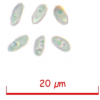
26-12-2025 21:19
Arnold BüschlenPithyella chalaudii Priou. Ist als Bryoparasit in

21-12-2025 09:32
Hello.A tiny ascomycete found embedded in wood in

18-12-2025 21:17
Pol DebaenstThe identification took me to Byssonectria deformi

24-12-2025 17:08
Hulda Caroline HolteHello, I have found this propoloid ascomycete on

21-12-2025 21:32
Pol DebaenstHello, Garden, Burgweg 19, Veurne, BelgiumOn 10/1
Possible Orbilia sp.
B Shelbourne,
24-12-2023 11:59
Just started looking at Ascos, and this is my third attempt to ID one with microscopy. I would appreciate any feedback and thanks for looking. Unfortunately I couldn't upload the individual photos without an error.
Several tiny, bright-orange, discomycetous ascomata on wood, collected accidentally on a sample with a suspected yellow Calycina sp. (microscopy not done).
Looks like Orbiliaceae, and I have tried to use the 2020 monograph by Baral et al. Lots of micromorphology to (mis)interpret, so I have not cropped and combined the microphotos.
Current Idea:
· Genus Orbilia: Macromorphology, croziers -, anchoring hyphae VBs -, singular SBs.
· Subgenus Orbilia, section Orbilia: VBs +, ascus base shapes, paraphyses, SB shape, (asco)spore shape.
· Series Orbilia: Spore size and shape, SB shape, paraphyse apices, glassy processes -.
· Similarities to O. tremulae and O. eucalypti group (part of Key A in Baral et al.), but hard to be confident with variable species and my inexperienced observations.
Storage and prep:
Kept attached to wood sample in the fridge in a water-tight container for 2-3 weeks. Ascomata visibly shrunken and darker, appeared to change more than ascomata of other species in the same container (desiccation sensitive?). Two slides prepared with different ascoma, 'rehydrated' for ~30 seconds in tap water on a slide before applying cover slip.
Description:
Habitat and conditions: Hygric wood (decorticated part), branch from deciduous tree, on the floor in mixed deciduous woodland, southern England, a few weeks ago after rain.
Ascomata: Diameter <= 0.5 mm, bright orange, translucent, broadly sessile, growing laterally if in crevices, relatively thick, margin slightly raised and maybe more lobate in maturity, no noticeable hairs or glassy processes, texture slightly rough.
Asci: five measured 34 - 41.5 × 3.3 - 3.5 µm, 8-spored, simple septa, base often furcate and variable (some H-shape), thin-walled, apex hemispherical in profile and noticeably truncate in forward view (including dead asci), no distinct apical chamber, some presumably living asci have more space around spores, several spores seem reversely oriented, but no clear pattern to positions and orientation identified.
Ascospores: Ovoid-elipsoid, aseptate, no noticeable tail or curvature, several small globose VBs, lots look bi-guttulate, some seem to be living; spore body singular, globose, seems apically attached but no filum seen, appearing as clear area in presumably dead spores, not clearly identified in some spores.
· Outside asci: 10 measured, 4 - 5 x 2.1 - 2.3 µm, Q = 1.8 – 2.4, some may be dead.
· Inside asci: 15 measured, (3.4) 3.7 - 4.8 (5) × 2.1 - 2.8 µm, Q = 1.4 - 2.3.
Exudate: Granular, yellow, with small crystals (SCBs?), relatively thin and easily disturbed, mature asci emerging, no gelatinous matrix.
Paraphyses: Mixture of uninflated (~1.7 µm) and medium to strongly clavate/capitate (~2.7-3.5 µm) apices, +/- symmetric, multi-septate, some apical cells appear longer, often several smallish globose VBs in each cell, some capitate apices with a larger VB, branching below the apical septa, not sure which VBs could be SCBs, occasionally exudate remaining.
Anchoring hyphae: ~(3) 4 - 5 µm wide with septa ~3 - 5 µm apart, no branching seen, brown walls, clear contents.
No anamorphic structures identified.
Hans-Otto Baral,
24-12-2023 12:34

Re : Possible Orbilia sp.
Yes, I suppose O. eucalypti. But spores and their contents not easy to see on your photos. Did you use oil immersion?
Exudate is outside the cells, SCBs inside. But here I think are no SCBs, only carotenoids in LBs of paraphyses.
Yes, surely desiccation-tolerant.
Zotto
B Shelbourne,
24-12-2023 13:18
Re : Possible Orbilia sp.
Thank you. I'm glad to hear that I might at least be in the right area.
I did use oil immersion, but it was very challenging to focus on the spore contents. I have this picture I collated from some spores I found outside asci and I will try to collate some more detailed views of the spore contents.
I think there are a few more ascomata on the piece of wood so I could try to look at another.
I did use oil immersion, but it was very challenging to focus on the spore contents. I have this picture I collated from some spores I found outside asci and I will try to collate some more detailed views of the spore contents.
I think there are a few more ascomata on the piece of wood so I could try to look at another.
B Shelbourne,
24-12-2023 16:44
Hans-Otto Baral,
24-12-2023 17:17

Re : Possible Orbilia sp.
Yes, now it is clear. This species has often no clear SB but only LBs in the spores.
Genetically it is very heterogeneous and it is an unsolved question whether they are worth to be treated as species since there is no morphology to distinguish them.
B Shelbourne,
24-12-2023 21:13
Re : Possible Orbilia sp.
Thank you very much for your help.
Maybe I didn't see any SBs then, just LBs.
I remember reading something similar about this species/group being tentative in the monograph, I guess these underlying 'species' must be rather cryptic. At least I can record it as O. eucalypti.
Maybe I didn't see any SBs then, just LBs.
I remember reading something similar about this species/group being tentative in the monograph, I guess these underlying 'species' must be rather cryptic. At least I can record it as O. eucalypti.
 AscoFr-photos-0001.pdf
AscoFr-photos-0001.pdf
